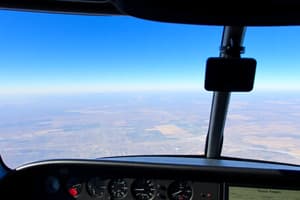Podcast
Questions and Answers
What are the three fundamental skills to altitude instrument flying?
What are the three fundamental skills to altitude instrument flying?
Instrument cross-check, instrument interpretation, aircraft controls.
What are the three groups of instruments in the control and performance method?
What are the three groups of instruments in the control and performance method?
Control instruments, performance instruments, navigation instruments.
What is the first step for performing the control and performance method?
What is the first step for performing the control and performance method?
Establish an attitude or power setting for the control instruments.
What are the primary and supporting instruments for pitch control during a constant rate climb?
What are the primary and supporting instruments for pitch control during a constant rate climb?
The heading indicator is considered the primary instrument for bank control.
The heading indicator is considered the primary instrument for bank control.
Which instrument is used as the primary instrument for airspeed during a standard rate climb?
Which instrument is used as the primary instrument for airspeed during a standard rate climb?
What do you need to do to maintain a constant heading while flying?
What do you need to do to maintain a constant heading while flying?
To recover from a nose-high unusual flight attitude, you should add _____ and level the wings.
To recover from a nose-high unusual flight attitude, you should add _____ and level the wings.
What is the primary instrument used for level flight during partial panel operations?
What is the primary instrument used for level flight during partial panel operations?
Which statement is true regarding applying the primary/support method of attitude instrument flying during a standard-rate turn?
Which statement is true regarding applying the primary/support method of attitude instrument flying during a standard-rate turn?
What does fixation IFR error refer to?
What does fixation IFR error refer to?
Mention one common error in attitude instrument flying.
Mention one common error in attitude instrument flying.
How do you avoid overshooting the desired roll-out heading during a standard-rate turn?
How do you avoid overshooting the desired roll-out heading during a standard-rate turn?
What is required when recovering from a nose-low instrument unusual flight attitude?
What is required when recovering from a nose-low instrument unusual flight attitude?
Flashcards are hidden until you start studying
Study Notes
Fundamental Skills for Instrument Flying
- Instrument cross-check: Systematic observation of flight instruments for optimal scanning.
- Instrument interpretation: Mastery of how instruments function and knowledge of their operation.
- Aircraft controls: Actions taken after cross-checking and interpreting instruments to adjust flight path.
Control and Performance Method
- Instrument groups: Control instruments (altitude, manifold pressure, RPM), performance instruments (airspeed, altimeter, turn coordinator, heading indicator, VSI), navigation instruments (OBS).
- Attitude indicator serves as the central hub for maintaining flight orientation.
Steps for Control and Performance Method
- Establish desired attitude or power settings.
- Trim to neutralize control pressures.
- Perform instrument cross-checks.
- Adjust attitude or power settings as needed.
Primary/Support Method Instruments
- Primary pitch instruments: airspeed, heading, altimeter.
- Supporting pitch: altitude indicator, VSI for pitch; manifold pressure and RPM for power.
Straight and Level Flight
- Power: Establish with manifold pressure and RPM, supported by airspeed indicator.
- Pitch: Establish with attitude indicator, supported by airspeed, altimeter, and VSI.
- Bank: Maintain heading using the heading indicator, supported by the attitude indicator and turn coordinator.
Standard Rate Turns
- Power: Monitor airspeed, support with manifold pressure and RPM.
- Pitch: Establish with attitude, supported by altimeter and VSI.
- Bank: Use attitude indicator, supported by turn and heading indicators.
Climbing and Descending
- Constant airspeed climb: Increase power, support with attitude, airspeed, altimeter, and VSI.
- Constant rate climb: Use vertical speed indicator as primary, supported by airspeed, attitude, and altimeter.
- Leveling off: Decrease pitch and cross-check altimeter and VSI.
Errors in Instrument Flying
- Fixation: Focusing on a single instrument, ignoring others.
- Omission: Excluding one or more instruments from scanning.
- Emphasis: Overreliance on familiar instruments versus comprehensive scans.
- Correction speed: Avoid rapid excessive corrections to prevent aggravating errors.
Recovery from Unusual Attitudes
- Nose high: Add power, place aircraft symbol on horizon, level wings.
- Nose low: Reduce power, level wings, raise nose to horizon line of attitude indicator.
Maintaining Heading
- Handle overshooting: Control bank angle during turns and reference turn coordinator for corrections.
- Use altimeter for level flight in partial panel scenarios and maintain smooth control inputs.
Handling Instrument Failures
- Analyze indications from functional instruments to verify data consistency.
- In partial panel scenarios, dowse on airspeed for pitch and altimeter for climbs/descents while cross-checking VSI.
General Best Practices
- Avoid heavy control inputs and rely on smooth adjustments.
- Regularly include magnetic compass in scans to ensure accurate heading maintenance.
- Maintain a light touch on controls for effective pressure feel during maneuvers.
Studying That Suits You
Use AI to generate personalized quizzes and flashcards to suit your learning preferences.




